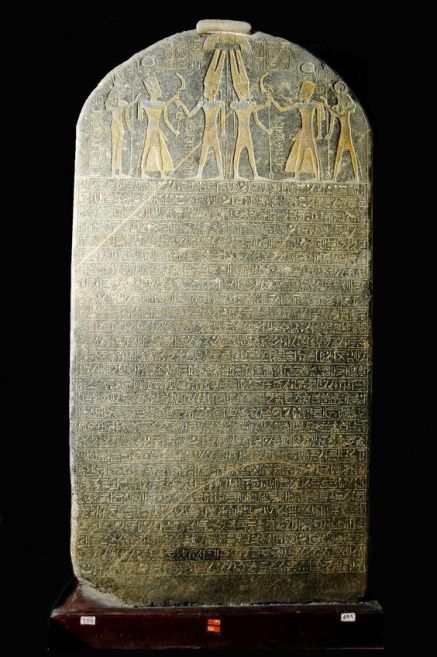
Discovered in western Thebes, Egypt, in 1896 by W.F. Petrie, the hieroglyphic inscription on this stele from 1208 B.C.E. contains the earliest surviving reference to “Israel” outside of the text of the Bible. The text on the stele commemorates a military campaign against Libya in the fifth regnal year of the Egyptian king Merneptah (1213-1203 B.C.E.). The inscription’s first twenty-three lines are a victory hymn, poetically recounting Merneptah’s military successes.
The last few lines of text from this stele briefly boast of Merneptah’s victories in the land of Canaan. The names of city-states and regions are mentioned in connection with exaggerated claims of Egyptian military expertise. Several inconclusive interpretations have been suggested regarding the textual arrangement of these geographic entites. 1 The grammatical determinative- a symbol that indicates the correct reading of the a name – attached to the name “Israel” indicates “people” rather than a land or city. 2 While the historical value of this fact has been debated due to some inconsistency in using determinatives in Egyptian inscriptions, this designation of Israel in 1208 B.C.E. as “people” resembles their portrayal in the text of the book of Joshua as a tribal, primarily rural, pre-monarchial people. Only the final few lines of the Merneptah stele mention Israel:
The princes are prostrate saying: “Shalom!”
Not one of the Nine Bows lifts his head:
Tjehenu is vanquished, Khatti at peace,
Canaan is captive with all woe.
Ashkelon is conquered, Gezer seized,
Yanoam made nonexistent;
Israel is wasted, bare of seed,
Khor is become a widow for Egypt.
All who roamed have been subdued.
By the King of Upper and Lower Egypt, Banere-meramun,
Son of Re, Merneptah, Content with Maat,
Given life like Re every day. 3
Notes
- Michael G. Hasel (9 June 2011). “The Battle Of Kadesh: Identifying New Kingdom Polities, Places, And Peoples In Canaan And Syria”. In S. Bar; D. Kahn; J.J. Shirley. Egypt, Canaan and Israel: History, Imperialism, Ideology and Literature: Proceedings of a Conference at the University of Haifa, 3-7 May 2009. BRILL. p. 67. See also J.A. Wilson, “Egyptian Hymns and Prayers,” in J.B. Pritchard (ed.) Ancient Near Eastern Texts Relating to the Old Testament (Princeton, NJ: Princeton University Press, 1955, 2nd ed.), p. 378 n. 18.
- J.K. Hoffmeier, ‘The Egyptian Origins of Israel: Recent Developments in Historiography,” in Thomas E. Levy, Thomas Schneider, William H.C. Propp (eds.) Israel’s Exodus in Transdisciplinary Perspective: Text, Archaeology, Culture, and Geoscience, Springer, 2015, p.196-208. Determinatives or semanagrams are placed at the end of a word, thus these characters serve to clarify what the word is about. Ankh Mi Ra (1995) writes, that determinatives are “picture signs that have no sound value and are appended to the end of a word. They serve to indicate the range of definitions that are applicable to a particular word. See Asar Imhotep, A Lesson in Egyptian Determinatives: The Case of KMT, p. 2. See also The Ancient Near East, volume 1: An Anthology of Texts and Pictures, by James B. Pritchard, p. 231 where J.A. Wilson writes: “Much has been made of the fact that the word Israel is the only one of the names in this context which is written with the determinative of people rather than land. Thus we should seem to have the Children of Israel in or near Palestine, but not yet as a settled people. This is a valid argument. Determinatives should have meaning, and a contrast between determinatives in the same context should be significant. This stela does give the country determinatives of people to unlocated groups like the Madjoi, Nau, and Tekten. The argument is good, but not conclusive, because of the notorious carelessness of Late-Egyptian scribes and several blunders of writing in this stela.
- Translation by Miriam Lichtheim, Ancient Egyptian Literature, Volume II (Berkeley: U of CA Press, 1976
